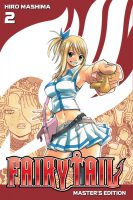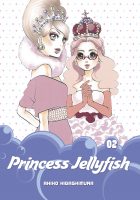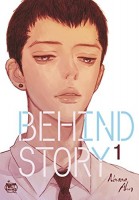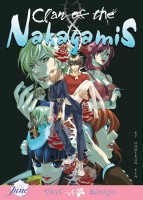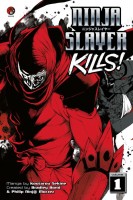My News and Reviews
The most recent manga giveaway at Experiments in Manga is currently underway! The winner will be announced on Wednesday, so there’s still a little time left to enter for a chance to win four of Kodansha Comics’ print debuts from 2017: Haruko Kumota’s Descending Stories: Showa Genroku Rakugo Shinju, Lily Hoshino’s Kigurumi Guardians, Haruko Ichikawa’s Land of the Lustrous, and Musawo’s Love & Lies. (Also, a couple other giveaways are going on right now that I would like to highlight: The Manga Test Drive’s annual holiday giveaway and Taneka Stott’s third annual queer comics giveaway.) Last week I finally managed to post the in-depth review that I’ve been working on for a while now, taking a closer look at Knights-Errant, Volume 1 by Jennifer Doyle. Knights-Errant is a fantastic comic, a queer-positive, dark historical fantasy with a compelling story and characters. I highly, highly recommend the series. (It can also be read online for free at Sparkler Monthly!) Initially I was intending to write one more in-depth review before the year was over (and before I retire Experiments in Manga), but after some thought I think that Knights-Errant will have the honor of receiving the last. However, I am still working on and will be posting my random musings on some of year’s notable releases, so there is that to look forward to.
Quick Takes
 Arakawa Under the Bridge, Omnibus 1 (equivalent to Volumes 1-2) by Hikaru Nakamura. My introduction to Arakawa Under the Bridge was through its anime adaptation, an incredibly quirky and bizarre work which I found to be highly entertaining. Only later did I discover that the creator of the original manga was also the creator of Saint Young Men, a series that I hope might one day be translated as well. (Despite interest from fans and publishers alike, Saint Young Men has been unlicensable for the North American market, but I can’t help hoping that if Arakawa Under the Bridge is successful that might change.) Arakawa Under the Bridge is an absolutely ridiculous manga and I enjoyed it immensely. The chapters are short and somewhat episodic so the narrative flow can be disjointed, but Nakamura eventually develops a nice rhythm as more of the increasingly large, and strange, cast is introduced. The absurdity of the characters is really what makes Arakawa Under the Bridge work. I’m particularly fond of Sister, an ex-mercenary who crossdresses as a nun, but the manga is filled with astonishing personalities.
Arakawa Under the Bridge, Omnibus 1 (equivalent to Volumes 1-2) by Hikaru Nakamura. My introduction to Arakawa Under the Bridge was through its anime adaptation, an incredibly quirky and bizarre work which I found to be highly entertaining. Only later did I discover that the creator of the original manga was also the creator of Saint Young Men, a series that I hope might one day be translated as well. (Despite interest from fans and publishers alike, Saint Young Men has been unlicensable for the North American market, but I can’t help hoping that if Arakawa Under the Bridge is successful that might change.) Arakawa Under the Bridge is an absolutely ridiculous manga and I enjoyed it immensely. The chapters are short and somewhat episodic so the narrative flow can be disjointed, but Nakamura eventually develops a nice rhythm as more of the increasingly large, and strange, cast is introduced. The absurdity of the characters is really what makes Arakawa Under the Bridge work. I’m particularly fond of Sister, an ex-mercenary who crossdresses as a nun, but the manga is filled with astonishing personalities.
 A Polar Bear in Love, Volume 1 by Koromo. Stories about star-crossed lovers aren’t especially rare, but none in my experience are quite like A Polar Bear in Love. Granted, at this point only one of the pair is actually in love. As impossible as it seems, Mr. Polar Bear as fallen for Li’l Seal. Understandably, considering the normal order of the food chain, Li’l Seal is a bit concerned by this. They’re both males, too, but the real issue is that Li’l Seal expects to be eaten at any moment. The power dynamics are a little tricky, but over the course of the first volume, Mr. Polar Bear demonstrates the earnestness of his love and at least tries not to be too pushy about his feelings. Li’l Seal slowly realizes he might not actually be on the menu, but that’s not going to solve everything about their relationship, either. A Polar Bear in Love can be both incredibly adorable and surprisingly dark, occasionally even at the same time. Even while being anthropomorphized, Li’l Seal and and Mr. Polar Bear also have to face more realistic concerns of survival. On the surface A Polar Bear in Love is delightfully silly manga, but it also has a thing or two to say about love and relationships.
A Polar Bear in Love, Volume 1 by Koromo. Stories about star-crossed lovers aren’t especially rare, but none in my experience are quite like A Polar Bear in Love. Granted, at this point only one of the pair is actually in love. As impossible as it seems, Mr. Polar Bear as fallen for Li’l Seal. Understandably, considering the normal order of the food chain, Li’l Seal is a bit concerned by this. They’re both males, too, but the real issue is that Li’l Seal expects to be eaten at any moment. The power dynamics are a little tricky, but over the course of the first volume, Mr. Polar Bear demonstrates the earnestness of his love and at least tries not to be too pushy about his feelings. Li’l Seal slowly realizes he might not actually be on the menu, but that’s not going to solve everything about their relationship, either. A Polar Bear in Love can be both incredibly adorable and surprisingly dark, occasionally even at the same time. Even while being anthropomorphized, Li’l Seal and and Mr. Polar Bear also have to face more realistic concerns of survival. On the surface A Polar Bear in Love is delightfully silly manga, but it also has a thing or two to say about love and relationships.
 To Your Eternity, Volume 1 by Yoshitoki Oima. I have been following Oima’s progress as an artist and storyteller with great interest. Oima’s first major work was the manga adaptation of Tow Ubukata’s novel Mardock Scramble, parts of which I actually greatly preferred over its source material. However, what really impressed me was her powerful original series, A Silent Voice. When Kodansha Comics announced it would be releasing To Your Eternity, Oima’s current ongoing series, I immediately took note and looked forward to reading it with great anticipation. The first chapter of To Your Eternity is one of the most beautifully devastating narratives that I’ve read in a while and it seems as though it may only be a prelude for what is to come. (It also includes a fairly significant plot twist which makes the series a little difficult to discuss without giving away major spoilers.) Oima has created a complex fantasy world complete with it’s own legends and lore exploring the meaning of life and loyalty to family and community. To Your Eternity is absolutely heartbreaking, unsettling, and striking in both its story and artwork. I definitely plan on reading more.
To Your Eternity, Volume 1 by Yoshitoki Oima. I have been following Oima’s progress as an artist and storyteller with great interest. Oima’s first major work was the manga adaptation of Tow Ubukata’s novel Mardock Scramble, parts of which I actually greatly preferred over its source material. However, what really impressed me was her powerful original series, A Silent Voice. When Kodansha Comics announced it would be releasing To Your Eternity, Oima’s current ongoing series, I immediately took note and looked forward to reading it with great anticipation. The first chapter of To Your Eternity is one of the most beautifully devastating narratives that I’ve read in a while and it seems as though it may only be a prelude for what is to come. (It also includes a fairly significant plot twist which makes the series a little difficult to discuss without giving away major spoilers.) Oima has created a complex fantasy world complete with it’s own legends and lore exploring the meaning of life and loyalty to family and community. To Your Eternity is absolutely heartbreaking, unsettling, and striking in both its story and artwork. I definitely plan on reading more.

